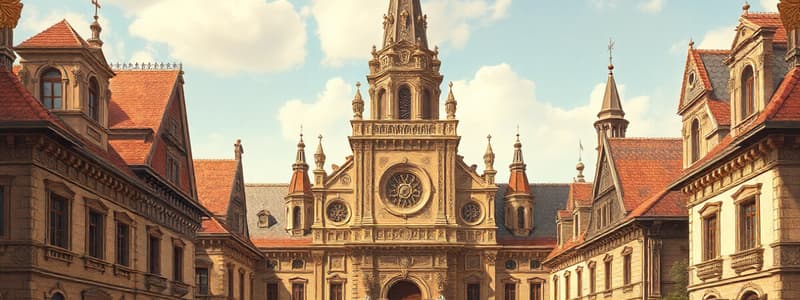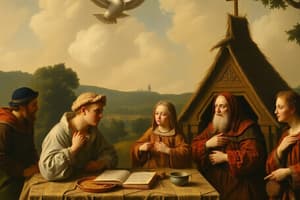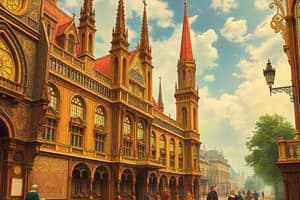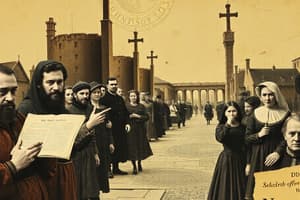Podcast
Questions and Answers
Given the multifaceted societal transformations of the Renaissance, which statement offers the most nuanced understanding of the relationship between the rediscovery of classical texts and the evolution of individual agency?
Given the multifaceted societal transformations of the Renaissance, which statement offers the most nuanced understanding of the relationship between the rediscovery of classical texts and the evolution of individual agency?
- While classical texts offered alternative frameworks for understanding the world, the concurrent rise of mercantile wealth and urban autonomy played a crucial role in fostering individual agency. (correct)
- The emphasis on classical ideals entirely superseded religious dogma, thus removing any prior restrictions on individual thought and action during the Renaissance.
- The rediscovery of classical texts provided a direct catalyst for the surge in individual agency by validating pre-Christian philosophical ideals.
- Individual agency during the Renaissance was solely a product of the rejection of feudal structures and had no tangible connection to classical learning.
Considering the complex interplay of factors that defined Italy as the birthplace of the Renaissance, what argument provides the most compelling explanation for the region's unique confluence of cultural and economic advantages?
Considering the complex interplay of factors that defined Italy as the birthplace of the Renaissance, what argument provides the most compelling explanation for the region's unique confluence of cultural and economic advantages?
- Italy's thriving city-states, classical heritage, and wealthy merchant class were entirely independent phenomena that coincidentally occurred in the same geographic region.
- The lack of a strong centralized authority in Italy, in contrast to the unified monarchies of Northern Europe, allowed for more flexible social structures and fostered a greater openness to innovation.
- Italy's geographic location as a crossroads of trade routes was the primary driver, with wealth accumulation predestined to translate into patronage and artistic flourishing.
- The concentration of wealth in Italian merchant families, coupled with the remnants of Roman infrastructure, created a self-reinforcing cycle of patronage and artistic production that was unmatched elsewhere. (correct)
How does Machiavelli's conception of virtù in "The Prince" challenge conventional ethical frameworks, and what ramifications does this have for assessing the legitimacy of political power?
How does Machiavelli's conception of virtù in "The Prince" challenge conventional ethical frameworks, and what ramifications does this have for assessing the legitimacy of political power?
- Machiavelli's virtù is purely amoral, advocating for any means necessary to secure power, thereby discarding all traditional notions of ethical governance.
- Machiavelli advocates for a return to classical virtues, emphasizing the importance of justice and temperance in governance to ensure long-term stability and popular support.
- Virtù, as Machiavelli defines it, incorporates traits that may be traditionally deemed immoral but are essential for maintaining state stability, thereby complicating assessments of legitimacy beyond simple ethical criteria. (correct)
- The concept of virtù is ultimately secondary to divine right, as Machiavelli believed that a prince's authority ultimately derives from God's will and is thus beyond human judgment.
What role did the printing press play in the dissemination of Reformation ideas, and how did it alter the dynamics of religious and political discourse in Europe?
What role did the printing press play in the dissemination of Reformation ideas, and how did it alter the dynamics of religious and political discourse in Europe?
Considering the complexity of Renaissance society, what factor best clarifies the divergence in expectations for Renaissance men and women, particularly concerning artistic creation and public recognition?
Considering the complexity of Renaissance society, what factor best clarifies the divergence in expectations for Renaissance men and women, particularly concerning artistic creation and public recognition?
How does the concept of 'Christian humanism,' as exemplified by figures like Erasmus and More, reconcile classical learning with religious piety, and what societal reforms did they advocate based on this synthesis?
How does the concept of 'Christian humanism,' as exemplified by figures like Erasmus and More, reconcile classical learning with religious piety, and what societal reforms did they advocate based on this synthesis?
Given the complex political landscape of 16th-century Europe, what rationale provides the most nuanced explanation for the varied responses of German princes to Luther's Reformation?
Given the complex political landscape of 16th-century Europe, what rationale provides the most nuanced explanation for the varied responses of German princes to Luther's Reformation?
Considering the long-term consequences of the Reformation, which argument offers the most compelling explanation for its impact on the development of modern nation-states and the decline of centralized religious authority?
Considering the long-term consequences of the Reformation, which argument offers the most compelling explanation for its impact on the development of modern nation-states and the decline of centralized religious authority?
How did the invention of the printing press transform the landscape of European intellectual life, and what were its implications for the democratization of knowledge and the rise of vernacular languages?
How did the invention of the printing press transform the landscape of European intellectual life, and what were its implications for the democratization of knowledge and the rise of vernacular languages?
Considering the multifaceted reforms enacted during the Catholic Reformation, what statement provides the most nuanced assessment of its aims and impact on the Catholic Church?
Considering the multifaceted reforms enacted during the Catholic Reformation, what statement provides the most nuanced assessment of its aims and impact on the Catholic Church?
Given the diverse social landscape of Renaissance Europe, what statement best evaluates the role of noblewomen in the Reformation and their ability to influence religious and political events?
Given the diverse social landscape of Renaissance Europe, what statement best evaluates the role of noblewomen in the Reformation and their ability to influence religious and political events?
In what ways did Renaissance artists and intellectuals draw inspiration from classical Greece and Rome, and how did their interpretations of classical antiquity shape the artistic and intellectual innovations of the period?
In what ways did Renaissance artists and intellectuals draw inspiration from classical Greece and Rome, and how did their interpretations of classical antiquity shape the artistic and intellectual innovations of the period?
What role did the concept of secularism play in shaping Renaissance society, and how did it influence attitudes toward religion, politics, and the pursuit of worldly pleasures?
What role did the concept of secularism play in shaping Renaissance society, and how did it influence attitudes toward religion, politics, and the pursuit of worldly pleasures?
Given Henry VIII's complex motivations for initiating the English Reformation, what is a good justification for his transformation of the Church?
Given Henry VIII's complex motivations for initiating the English Reformation, what is a good justification for his transformation of the Church?
How did Elizabeth I navigate the religious divisions within English society during her reign, and what strategies did she employ to maintain stability and consolidate her authority?
How did Elizabeth I navigate the religious divisions within English society during her reign, and what strategies did she employ to maintain stability and consolidate her authority?
To what extent did the Reformation challenge traditional notions of religious authority and social hierarchy, and how did it contribute to the rise of individualism and democratic ideals?
To what extent did the Reformation challenge traditional notions of religious authority and social hierarchy, and how did it contribute to the rise of individualism and democratic ideals?
Considering the societal shifts and intellectual realignments of the Renaissance and Reformation, what statement best describes the long-term impact of these periods on European history?
Considering the societal shifts and intellectual realignments of the Renaissance and Reformation, what statement best describes the long-term impact of these periods on European history?
Given the complex relationships between religious belief, political power, and social order in 16th-century Europe, what argument best explains the causes and consequences of the St. Bartholomew's Day Massacre?
Given the complex relationships between religious belief, political power, and social order in 16th-century Europe, what argument best explains the causes and consequences of the St. Bartholomew's Day Massacre?
In considering the role of women in the Renaissance and Reformation, how should we interpret the emphasis on female education and literary production among elite women, such as Isabella d'Este and Christine de Pizan, in relation to prevailing patriarchal norms?
In considering the role of women in the Renaissance and Reformation, how should we interpret the emphasis on female education and literary production among elite women, such as Isabella d'Este and Christine de Pizan, in relation to prevailing patriarchal norms?
With regards to the artistic innovations of the Renaissance, how can we attribute advancements such as linear perspective and sfumato, not merely as technical improvements, but as reflections of the era's shifting worldview?
With regards to the artistic innovations of the Renaissance, how can we attribute advancements such as linear perspective and sfumato, not merely as technical improvements, but as reflections of the era's shifting worldview?
What underlying principles that contributed to the religious and ethical systems in the Renaissance can be viewed as more impactful in the long-term?
What underlying principles that contributed to the religious and ethical systems in the Renaissance can be viewed as more impactful in the long-term?
Flashcards
Renaissance Definition
Renaissance Definition
Means rebirth, refers to a revival of art and learning.
Humanism
Humanism
An intellectual movement that focused on human potential and achievements.
Secular
Secular
Worldly rather than spiritual and concerned with the here and now.
Patron Definition
Patron Definition
Signup and view all the flashcards
Perspective Definition
Perspective Definition
Signup and view all the flashcards
Vernacular Definition
Vernacular Definition
Signup and view all the flashcards
The Courtier
The Courtier
Signup and view all the flashcards
Indulgence Definition
Indulgence Definition
Signup and view all the flashcards
95 Theses
95 Theses
Signup and view all the flashcards
Reformation
Reformation
Signup and view all the flashcards
Protestant Definition
Protestant Definition
Signup and view all the flashcards
Excommunication
Excommunication
Signup and view all the flashcards
Edict of Worms
Edict of Worms
Signup and view all the flashcards
Protestants
Protestants
Signup and view all the flashcards
Peace of Augsburg
Peace of Augsburg
Signup and view all the flashcards
Annul Definition
Annul Definition
Signup and view all the flashcards
Act of Supremacy
Act of Supremacy
Signup and view all the flashcards
Huguenots Definition
Huguenots Definition
Signup and view all the flashcards
Theocracy Definition
Theocracy Definition
Signup and view all the flashcards
Predestination
Predestination
Signup and view all the flashcards
Presbyterians
Presbyterians
Signup and view all the flashcards
Anabaptists Definition
Anabaptists Definition
Signup and view all the flashcards
Jesuits
Jesuits
Signup and view all the flashcards
Council of Trent
Council of Trent
Signup and view all the flashcards
Political Effects to the Reformation
Political Effects to the Reformation
Signup and view all the flashcards
Utopia
Utopia
Signup and view all the flashcards
Study Notes
Renaissance and Reformation Overview (1300-1600)
- This era saw new European cultural and artistic ideas because of trade with the East and the rediscovery of ancient manuscripts.
- The "Renaissance" means rebirth.
- Martin Luther started a movement to change what he thought were incorrect Catholic Church ways.
- The Reformation, as led by Martin Luther, led to the creation of non-Catholic churches.
- The printing press made books and pamphlets more quickly and cheaply.
- This increased the speed at which revolutionary Renaissance and Reformation ideas spread.
Renaissance Art and Society
- Painting, sculpture, and drawing saw huge growth
- Talented artist started to express ideas and attitudes
- Raphael's School of Athens shows how humanism valued greek philosophers
- Portraits like DaVinci's Mona Lisa is an expression of unique personality and traits
- Michelangelo's David shares stylistic qualities with ancient Roman/Greek sculpture
Italy as the Starting Point of the Renaissance
- Europe went through war and plague in the late Middle Ages.
- Survivors wanted to celebrate life/human spirit, question the institutions of the Middle Ages, and the Church.
- Writers/artists in Northern Italy began to express this new spirit and experiment with styles.
- Italy had advantages as the birthplace of the Renaissance: thriving cities, a wealthy merchant class, and classical heritage.
- Crusades spurred overseas trade and led to the growth of large city-states in northern Italy.
- Northern Italy was more urban than the rest of Europe, creating a breeding ground for intellectual evolution.
- The bubonic plague struck hard in the 1300s, killing up to 60% of the population, leading to economic changes and merchants pursuing art.
Merchants, Medici, and the Importance of Individualism
- Merchants, unlike nobles, did not inherit social rank, causing them to believe they deserved power because of individual merit.
- The belief in individual achievement became important in the Renaissance.
- The Medici family, a powerful banking family, came to rule Florence during the Renaissance
- Cosimo de Medici controlled Florence's government for 30 years by influencing the ruling council with loans, without seeking political office directly.
- Renaissance scholars looked down on Middle Age art/literature, pursuing Greek and Roman learning via ruins, manuscripts, and scholars fleeing to Rome with Greek manuscripts.
Classical and Secular Values
- Classical texts study led to Humanism
- Humanism is an intellectual movement focusing on human potential and achievements instead of Christian teachings
- Humanists influenced artists/architects to continue classical traditions and popularized humanities
- While most people stayed devout Catholics, Renaissance society developed a basic spirit that was worldly rather than spiritual
- Rich people enjoyed material luxuries, good music, and fine foods, flaunting wealth
- Church leaders patronized arts and had portraits/donated art to public squares
Qualities of the Ideal Man and Women
- Renaissance writers believed all educated people should create art.
- The ideal person strove to master almost every area of study
- Baldassare Castiglione's The Courtier (1528) taught how to be a Renaissance man: charming, witty, educated, dance, sing, play music, write poetry, skilled rider, wrestler, and swordsman.
- Upper-class women also should know the classics and be charming, but inspire art, not seek fame.
- Women were expected to support art but rarely create it and have little influence in politics
- Isabella d’Este was born into the ruling family of Ferrara and married the ruler of Mantua, bringing Renaissance artists to her court, made an art collection and defended Mantua, after her husband was captured.
Renaissance Art Innovations
- Patrons like Isabella d’Este helped dozens of artists to create
- Artistic styles changed, religious subjects were portrayed using a realistic style copied from classical models
- Greek/Roman subjects became popular; techniques of perspective used
- Realistic paintings and sculptures: painters painted prominent citizens
- Michelangelo Buonarroti realistic style when depicting human body
- Donatello's sculptures: natural postures and expressions.
- Donatello's statue of David was the first European free-standing nude statue since ancient times
- DaVinci Mona Lisa is a expressive realistic portrait
- DaVinci's Last Supper shows personalities of Jesus' disciples through facial expressions
- Raphael Sanzio portrayed his subjects' expression as gentle and calm as influenced by their works
- Raphael used perspective techniques and filled the walls of Pope Julius II’s library with paintings like School of Athens
- There were some Italian women who became notale painters
Literature and the Arts
- Italian women generally had restricted rules
- Some painters were Sofonisba Anguissola and Artemisia Gentileschi
- Gentileschi painted pictures of strong, heroic women.
- Renaissance writers such as medieval writer Dante Alighieri used techniques and concepts of the ancient world.
- Dante Alighieri wrote in vernacular language
- Petrarch was one of the earliest inflential humanists
- Boccaccio wrote the realistic but sometimes odd Decameron
- Macchiavelli wrote the Prince, which suggest ruler should gain but maintain power
Other Key Figures and Themes
- The women writers typically used less polemical, more intimate tone.
- Famous women wriiter was Vittoria Colonna, sonnet writer
- During the Renaissance, the arts become more accessible to the public.
Northern Renaissance Characteristics
- Italian Renaissance ideas mingled with northern traditions as ideas spread out of Inaly, and developed its own distinct character.
- Northern Renaissance artists were especially interested in realism
- The Renaissance ideal of human dignity inspired some northern humanists to development plans of social reform based on Judeo-Christian values.
Northern Artistic Ideas Spread
- Northern Europes population grew beginning in 1450
- The merchants became wealthy from textiles
- In 1453 France and England saw urban merchants become rich enough to act as patrons -Italian art techniques styles mixed with traditions of northen making renais
- Northern ideal on human dignity inspired huminists
- In 1494, a French king claimed the throne of Naples.
- Northern Euros studied in Italy to then bring homeland
Key Northern Painters
- Albrecht Dürer traveled to Italy to study in 1494, then created religious/myth/realistic prints
- Dürer’s emphasis on realism influenced Hans Holbein
- Wealthy merchant families in Flanders supported Jan van Eyck as well as development of oil based painting
- Pieter Bruegel the Elder was also interested in realistic details and individual people
Literature and Reform
- Italian humanists inspired northern people to study Christian teachings with goal of Christian humanism/reform
- Some Humanists wanted society reformed and focused on women education
- Desiderius Erasmus wrote The Praise of Folly which poked fun at greedy merchants, lovers, scholars, and priests and supported all studying the Bible to better society
- Thomas More wrote Utopia: an ideal place with little greed
- Christine de Pizan wrote The Book of The City of Ladies questioned why girls not educated
Elizabethan Era Characteristics in Renaissance
- The Elizabethan Age, named after Queen Elizabeth I, was the mid 15
Studying That Suits You
Use AI to generate personalized quizzes and flashcards to suit your learning preferences.
Related Documents
Description
Explore the cultural and artistic rebirth during the Renaissance (1300-1600). Learn about the Reformation led by Martin Luther, the rise of non-Catholic churches, and the impact of the printing press. Discover Renaissance art and the expression of humanism.




